NCERT Exemplar: Areas Related to Circles | Mathematics (Maths) Class 10 PDF Download
| Table of contents |

|
| Exercise 11.1 |

|
| Exercise 11.2 |

|
| Exercise 11.3 |

|
| Exercise 11.4 |

|
Exercise 11.1
Choose the correct answer from the given four options:
Q.1. If the sum of the areas of two circles with radii R1 and R2 is equal to the area of a circle of radius R, then
(a) R1 + R2 = R
(b) 
(c) R1 + R2 < R
(d) 
Correct Answer is Option (b)
Radius of first circle = R1
Area of first circle = πR12
Radius of second circle = R2
Area of second circle = πR22
Radius of third circle = R
Area of third circle = πR2
According to question
πR12 + πR22 = πR2
π(R12 + R22) = πR2
R12 + R22 = R2
Hence option B is correct.
Q.2. If the sum of the circumferences of two circles with radii R1 and R2 is equal to the circumference of a circle of radius R, then
(a) R1 + R2 = R
(b) R1 + R2 > R
(c) R1 + R2 < R
(d) Nothing definite can be said about the relation among R1, R2 and R.
Correct Answer is Option (a)
According to the question,
Circumference of circle with radius R = Circumference of first circle with radius R1 + Circumference of second circle with radius R2
∴ 2πR = 2πR1+ 2πR2
⇒ R = R1+ R2
∴ Option A is correct.
Q.3. If the circumference of a circle and the perimeter of a square are equal, then
(a) Area of the circle = Area of the square
(b) Area of the circle > Area of the square
(c) Area of the circle < Area of the square
(d) Nothing definite can be said about the relation between the areas of the circle and square.
Correct Answer is Option (b)
Let the radius of the circle ber.
∴ Area of Circle = πr2 .
and the circumference = 2πr
The perimeter of the square is equal to circumference of circle.
∴ Its one side = 1/4 × 2πr = πr/r.
So Area of Square = (πr/r)2.
∴ Area of Square/Area of circle = πr2 :
So, Area of Circle > Area of Square.
Q.4. Area of the largest triangle that can be inscribed in a semi-circle of radius r units is
(a) r2sq. units
(b) 1/2 r2 sq. units
(c) 2 r2 sq. units
(d) √2 r2 sq. units
Correct Answer is Option (a)
The largest triangle is isosceles triangle and Area = 1/2r2 × 2 = r2
Q.5. If the perimeter of a circle is equal to that of a square, then the ratio of their areas is
(a) 22 : 7
(b) 14 : 11
(c) 7 : 22
(d) 11: 14
Correct Answer is Option (b)
Let radius of circle be r and side of a square be a.
Perimeter of a circle = Perimeter of a square
∴ 2πr = 4a
⇒ a = πr/2 .....(i)
Now, Area of circle/Area of square =......[From equation (i)]
= 14/11
Q.6. It is proposed to build a single circular park equal in area to the sum of areas of two circular parks of diameters 16 m and 12 m in a locality. The radius of the new park would be
(a) 10 m
(b) 15 m
(c) 20 m
(d) 24 m
Correct Answer is Option (a)
Let the radius of new park be r.
∴πr2 = π(8)2 + π(6)2
⇒ πr2 = 64π + 36π
⇒ πr2 = 100π
⇒ r = 10m
Q.7. The area of the circle that can be inscribed in a square of side 6 cm is
(a) 36 π cm2
(b) 18 π cm2
(c) 12 π cm2
(d) 9 π cm2
Correct Answer is Option (d)
Given, side of square = 6cm∴ Diameter of a circle, (d) = side of square = 6cm
∴ Radius of a circle (r) = d/2 = 6/2 = 3cm
∴ Area of circle= π(r)2
= π(3)2 = 9πcm2
Q.8. The area of the square that can be inscribed in a circle of radius 8 cm is
(a) 256 cm2
(b) 128 cm2
(c) 64√2 cm2
(d) 64 cm2
Correct Answer is Option (b)
Diagonal of square inscribed in a circle = Diameter of circle.
Therefore, d = 8 + 8 = 16cm
Side of square, a = d/ √2 = 16√2
Area of square =
Q.9. The radius of a circle whose circumference is equal to the sum of the circumferences of the two circles of diameters 36cm and 20 cm is
(a) 56 cm
(b) 42 cm
(c) 28 cm
(d) 16 cm
Correct Answer is Option (c)
Diameter of first circle = d1 = 36 cm
Diameter of second circle = d2 = 20 cm
∴ Circumference of first circle = πd1 = 36π cm
Circumference of second circle = πd2 = 20π cm
Now, we are given that,
Circumference of circle = Circumference of first circle + Circumference of second circle
πD = πd1 + πd2
⇒ πD = 36π + 20π
⇒ πD = 56π
⇒ D = 56
⇒ Radius = 56/2 = 28 cm
Q.10. The diameter of a circle whose area is equal to the sum of the areas of the two circles of radii 24 cm and 7 cm is
(a) 31 cm
(b) 25 cm
(c) 62 cm
(d) 50 cm
Correct Answer is Option (d)
Area of first circle = πr2 = π(24)2 = 576π m2
Area of second circle = πr2 = π(7)2 = 49π m2
Now, we are given that,
Area of the circle = Area of first circle + Area of second circle
∴ πR2 = 576π +49π
(where, R is the radius of the new circle)
⇒ πR2 = 625π
⇒ R2 = 625
⇒ R = 25
∴ Radius of the circle = 25cm
Thus, diameter of the circle = 2R = 50 cm.
Exercise 11.2
Q.1. Is the area of the circle inscribed in a square of side a cm, πa2 cm2? Give reasons for your answer.
No, Let a be the side of square.
We are given that the circle is inscribed in the square.Diameter of circle = Side of square = a
Radius of the circle = a/2
Area of the circle = πr2 = π(a/2)2 = (πa2)/4 cm2
Hence, area of the circle is (πa2)/4 cm2
Thus the area of the circle inscribed in a square of side a cm is not a2 cm2
Q.2. Will it be true to say that the perimeter of a square circumscribing a circle of radius a cm is 8a cm? Give reasons for your answer.
Yes, Let r be the radius of circle = a cm
∴ Diameter of the circle = d = 2 × Radius = 2a cm
As the circle is inscribed in the square, therefore,
Side of a square = Diameter of circle = 2a cm
Hence, Perimeter of a square = 4 × (side) = 4 × 2a = 8a cm
Q.3. In Fig 11.3, a square is inscribed in a circle of diameter d and another square is circumscribing the circle. Is the area of the outer square four times the area of the inner square? Give reasons for your answer.
Given diameter of circle is d.
∴ Diagonal of inner square = Diameter of circle = d
Let side of inner square EFGH be x.
∴ In right angled ΔEFG,
But side of the outer square ABCS = Diameter of circle = d
∴ Area of outer square = d2
Hence, area of outer square is not equal to four times the area of the inner square.
Q.4. Is it true to say that area of a segment of a circle is less than the area of its corresponding sector? Why?
It is not true because in case of major segment, area is always greater than the area of its corresponding sector. It is true only in the case of minor segment.
Thus, we can conclude that it is not true to say that area of a segment of a circle is less than the area of its corresponding sector.
Q.5. Is it true that the distance travelled by a circular wheel of diameter d cm in one revolution is 2 π d cm? Why?
The given statement is is not true because the distance travelled by the wheel in one revolution is equal to its circumference.
⇒ Distance travelled = π d
⇒ Distance travelled = π (2 r) = 2πr [i.e. Circumference of wheel]
Q.6. In covering a distance s metres, a circular wheel of radius r metres makes S/2πr revolutions. Is this statement true? Why?
The distance travelled by a circular wheel of radius r m in one revolution is equal to the circumference of the circle = 2πr
No. of revolutions completed in 2πr m distance = 1
No. of revolutions completed in 1 m distance = (1/2πr)
No. of revolutions completed in s m distance = (1/2πr) × s = s/2πr
Thus, the statement “in covering a distance s metres, a circular wheel of radius r metres makes s/2πr revolutions” is true.
Q.7. The numerical value of the area of a circle is greater than the numerical value of its circumference. Is this statement true? Why?
If 0< r< 2, then numerical value of circumference is greater than numerical value of area of circle and if r > 2, area is greater than circumference.
Q.8. If the length of an arc of a circle of radius r is equal to that of an arc of a circle of radius 2 r, then the angle of the corresponding sector of the first circle is double the angle of the corresponding sector of the other circle. Is this statement false? Why?
Consider two circles C1 and C2 of radii r and 2r respectively.
Let the length of two arcs be l1 and l2.
Accordingl1 = l2
⇒ θ1 = 2θ2
i.e., Angle of sector of the 1st circle is twice the angle of the sector of the other circle. Hence, the given statement is true.
Q.9. The areas of two sectors of two different circles with equal corresponding arc lengths are equal. Is this statement true? Why?
No, Area of first sector = (1/2)(r1)2θ1 ,
where r1 is the radius,
θ1 is the angle in radians subtended by the arc at the center of the circle.
Area of second sector = (1/2)(r2)2θ2,
where r2 is the radius,
θ2 is the angle in radians subtended by the arc at the center of the circle.
Given that: (1/2)(r1)2θ1 = (1/2)(r2)2θ2
⇒ (r1)2θ1 = (r2)2θ2
It depends on both radius and angle subtended at the center. But arc length only depends on radius of the circle. Therefore, it is not necessary that the corresponding arc lengths are equal. It is possible only if corresponding angles are equal (because then, the corresponding radii will be equal and hence the arc lengths will be equal).
Q.10. The areas of two sectors of two different circles are equal. Is it necessary that their corresponding arc lengths are equal? Why?
Yes, It is true for arcs of the same circle. But in different circle, it is not possible.
Q.11. Is the area of the largest circle that can be drawn inside a rectangle of length a cm and breadth b cm (a > b) is π b2 cm2? Why?
The largest circle that can be drawn inside a rectangle is possible when rectangle becomes a square.
∴ Diameter of the circle = Breadth of the rectangle = b
∴ Radius of the circle = b/2
Hence area of the circle = πr2 = π(b/2)2
Q.12. Circumferences of two circles are equal. Is it necessary that their areas be equal? Why?
True, If circumference of two circles are equal, then their corresponding radii are equal. So, their areas will be equal.
Q.13. Areas of two circles are equal. Is it necessary that their circumferences are equal? Why?
True, If areas of two circles are equal, then their corresponding radii are equal. So, their circumference will be equal.
Q.14. Is it true to say that area of a square inscribed in a circle of diameter p cm is p2 cm2? Why?
False, When the square is inscribed in the circle, the diameter of a circle is equal to the diagonal of a square but not the side of the square.
Let side of square = a
∴ p2 = a2 + a2⇒ p2 = 2a2
⇒ a2 = p2/2
Hence area of square = a2 = p2/2
Exercise 11.3
Q.1. Find the radius of a circle whose circumference is equal to the sum of the circumferences of two circles of radii 15 cm and 18 cm.
Let the radius of a circle be r.
∴ Circumference of a circle = 2πr
Let the radii of two circles are r and r whose values are 15 cm and 18 cm respectively.
i.e. r1 = 15 cm and r2 = 18 cm
Now, by given condition,
Circumference of circle = Circumference of first circle + Circumference of second circle
⇒ 2πr = 2πr1 + 2πr2
⇒ r = r1 + r2
⇒ r = 15 + 18
∴ r = 33 cm
Hence, required radius of a circle is 33 cm.
Q.2. In Fig. 11.5, a square of diagonal 8 cm is inscribed in a circle. Find the area of the shaded region.
Let the side of a square be a and the radius of circle be r.
Given that, length of diagonal of square = 8 cm
So, the area of the shaded region = Area of circle – Area of square
= (16π – 32) cm2
Hence, the required area of the shaded region is (16π – 32) cm2.
Q.3. Find the area of a sector of a circle of radius 28 cm and central angle 45°.
Sector (OAPBO) of a circle is given whose
radius(r)=28cm
and central angle (θ) = 45∘
∴ Area of sector (A)= πr2θ /360∘
⇒ Area of sector = 308 cm2 is the required area.
Q.4. The wheel of a motor cycle is of radius 35 cm. How many revolutions per minute must the wheel make so as to keep a speed of 66 km/h?
Radius of wheel = r = 35 cm
1 revolution of the wheel = Circumference of the wheel
= 2πr
= 2 × (22/7) × 35
= 220 cm
But, given that,
Speed of the wheel = 66 km/hr
= (66×1000×100)/60 cm/min
= 110000 cm/min
∴ Number of revolutions in 1 min = 110000/220 = 500
Hence, required number of revolutions per minute is 500.
Q.5. A cow is tied with a rope of length 14 m at the corner of a rectangular field of dimensions 20m × 16m. Find the area of the field in which the cow can graze.
Let ABCD be a rectangular field.
Length of field = 20 m
Breadth of the field = 16 mAccording to the question,
A cow is tied at a point A.
Let length of rope be AE = 14 m = l.
Angle subtended at the center of the sector = 90°
Angle subtended at the center (in radians) θ = 90π/180 = π/2
∴ Area of a sector of a circle = ½ r2θ
= ½ × (14)2 × (π/2)
= 154 m2
Hence, the required area of a sector of a circle is 154 m2.
Q.6. Find the area of the flower bed (with semi-circular ends) shown in Fig. 11.6.
Observing the figure, we get to know that It contains one rectangle of dimensions 38 cm × 10 cm and two semi-circles of diameters 10 cm. Area of Figure = Area of Rectangle + 2 × Area of Semicircle
Area of Rectangle = 38 × 10 = 380 cm2
Area of Semi-Circle =
Area of figure =
Hence, option D is the correct answer.
Q.7. In Fig. 11.7, AB is a diameter of the circle, AC = 6 cm and BC = 8 cm. Find the area of the shaded region (Use π = 3.14).
Given, AB is the diameter of the circle.
The sides of triangle AC = 6 cm and BC = 8 cm
We have to find the area of the shaded region.
We know that a triangle in a semicircle is a right angled triangle with hypotenuse as diameter.
So, ACB is a right triangle with C at right angle
By pythagoras theorem,
AB² = AC² + BC²
AB² = (6)² + (8)²
AB² = 36 + 64
AB² = 100
Taking square root,
AB = 10 cm
Area of triangle = (1/2) × base × height
Area of triangle ABC = (1/2) × AC × BC
= (1/2) × 6 × 8
= 48/2
= 24 cm²
Diameter of circle = AB = 10 cm
Radius = 10/2 = 5 cm
Area of circle = πr²
= (3.14)(5)(5)
= (3.14)(25)
= 78.5 cm²
Area of shaded region = area of circle - area of triangle
= 78.5 - 24
= 54.5 cm²
Q.8. Find the area of the shaded field shown in Fig. 11.8.
In the figure, join ED.
From figure, radius of semi circle DFE , r = 6 – 4 = 2 m
Now, area of rectangle ABCD = BC × AB = 8 × 4 = 32 m2
Area of semi - circle DFE =∴ Area of shaded region = Area of rectangle ABCD + Area of semi-circle DFE= (32 + 2π)m2
Q.9. Find the area of the shaded region in Fig. 11.9.
Join GH and FE
Here, breadth of the rectangle BC = 12m∴ Breadth of the inner rectangle EFGH = 12 − (4 + 4) = 4cmwhich is equal to the diameter of the semi-circle EJF, d = 4m∴ Radius of semi-circle EJF , r = 2m∴ Length of inner rectangle EFGH = 26 − (5+5) = 16m
∴ Area of two semi-circles EJF and HIG == 4πm
Now, area of inner rectangle EFGH = EH × FG = 16 × 4 = 64m2
and area of outer rectangle ABCD = 26 × 12 = 312m2
∴∴ Area of shaded region = Area of outer rectangle - (Area of two semi - circles + Area of inner rectangle)
= 312 − (64 + 4π) = (248 = 4π)m2
Q.10. Find the area of the minor segment of a circle of radius 14 cm, when the angle of the corresponding sector is 60°.
Area of the minor segment is given by πr2 × θ/360o − r2 sin θ/2 cos θ/2
= πr2 × 60o/360o − r2 sin 30o
= 22/7 × 14 × 14 × 1/6 − 14 × 14 × 1/2 × √3/2
= (308/3 − 49√3)cm2
Q.11. Find the area of the shaded region in Fig. 11.10, where arcs drawn with centres A, B, C and D intersect in pairs at mid-points P, Q, R and S of the sides AB, BC, CD and DA, respectively of a square ABCD (Use π = 3.14).
Area of all four sectors made by square and circle are equal.
And each sector have an angle of 90°
And radius of circle is 12/2 cm = 6 cm
Area of shaded region = Area of square ABCD − 4 × Area of one sector
⇒ Area of shaded region = Area of square ABCD − Area of circle with radius 6 cm
= 12 × 12−π × 62 cm2
= 144−113.04 cm2
= 30.96 cm2
Q.12. In Fig. 1 1.11, arcs are drawn by taking vertices A, B and C of an equilateral triangle of side 10 cm. to intersect the sides BC, CA and AB at their respective mid-points D, E and F. Find the area of the shaded region (Use π = 3.14).
From the given figure, area of the shaded part is equal to the sim of areas of these sectors at points A, B and C.
As ΔABC is equilateral triangle of side 10 cm and radius of the sectoris half of the side. All the three sectors are identical
θ = 60°
Radius of each sector(r) = 10/2 = 5 cm
∴ Area of shaded part = 3 .(Area of sector)
=1.57 × 25 = 39.25 cm2
Q.13. In Fig. 11.12, arcs have been drawn with radii 14 cm each and with centres P, Q and R. Find the area of the shaded region.
The area of the shaded region is equal to the sum of areas of three sectors of same radius but of different angles θ1, θ2 and θ3.
∠θ1 + ∠θ2 + ∠θ3 = 180° [Int. ∠s of Δ]
∴ Area of shaded region =
where r1 = r2 = r3 = r = 14 cm
∴ Area of shaded region = 308 cm2
Hence, required area = 308 cm2.
Q.14. A circular park is surrounded by a road 21 m wide. If the radius of the park is 105 m, find the area of the road.
Radius of the circular park, r = 105 m
Width of the road, d = 21 m
So, outer radius, r ′ = r + d = 126 m
Now, area of the road = area of the outer circle - area of the inner circle
= π × 1262 − π × 1052 = π(1262 − 1052)
= 22/7 × (126 + 105) × (126 − 105)
= 15246 m2
Q.15. In Fig. 11.13, arcs have been drawn of radius 21 cm each with vertices A, B, C and D of quadrilateral ABCD as centres. Find the area of the shaded region.
Area of each sector is equal.
Area of shaded region =
= 22/7 × 212
= 1386 cm2
Q.16. A piece of wire 20 cm long is bent into the form of an arc of a circle subtending an angle of 60° at its centre. Find the radius of the circle.
Length of arc of circle = 20 cm
Here, central angle θ = 60∘
∴ Length of arc = θ/360∘ × 2πr
r = 60/π cm
Hence, the radius of circle is 60/π cm
Exercise 11.4
Q.1. The area of a circular playground is 22176 m2. Find the cost of fencing this ground at the rate of Rs 50 per metre.
Given, area of circular playground is 22176 m²
We have to find the cost of fencing this ground at the rate of Rs 50 per metre.
Area of circle = πr²
Where r is the radius
22176 = (22/7)r²
r² = 22176(7)/22
r² = 7056
Taking square root,r = 84 m
Circumference of circle = 2πr
Circumference of circular playground = 2(22/7)(84)
= 2(22)(12)
= 44(12)
= 528 m
Given, cost of fencing per meter = Rs. 50
Cost of fencing 528 m = 528(50)
= Rs. 26400
Therefore, the cost of fencing is Rs. 26400
Q.2. The diameters of front and rear wheels of a tractor are 80 cm and 2 m respectively. Find the number of revolutions that rear wheel will make in covering a distance in which the front wheel makes 1400 revolutions.
Given, the diameter of front and rear wheels of a tractor are 80 cm and 2 m.
We have to find the number of revolutions that the rear wheel will make in covering a distance in which the front wheel makes 1400 revolutions.
Number of revolutions = total distance / distance covered in one revolution
Distance covered in one revolution = 2πr
Given, diameter of front wheel, 2r = 80 cm
Distance covered in one revolution by the front wheel = 80π
Given, diameter of rear wheel, 2r = 2 m
1 m = 100 cm
So, diameter of rear wheel, 2r = 200 cm
Distance covered in one revolution by the rear wheel = 200π
Given, total number of revolutions by front wheel = 1400
So, total distance covered by front wheel = number of revolutions × distance covered in one revolution
= 1400(80π)
= 112000π cm
Let the number of revolutions by the rear wheel be c
Distance travelled by rear wheel = number of revolutions × distance covered in one revolution
= c × 200π
Both the wheels travel the same distance.
So, 112000π = c × 200π
112000 = c × 200
c = 112000/200
c = 1120/2
c = 560
Therefore, the number of revolutions made by the rear wheel is 560.
Q.3. Sides of a triangular field are 15 m, 16 m and 17 m. With the three corners of the field a cow, a buffalo and a horse are tied separately with ropes of length 7 m each to graze in the field. Find the area of the field which cannot be grazed by the three animals.
Given radius of each sector = 7m
Now area of sector with ∠C
Area of the sector with ∠B =
And area of the sector with ∠H =
Therefore sum of the areas =
Semiperimeter = 24 m
Therefore area of the triangular field =
= 24√21m2
So area which can not be grazed =(24√21 −77)m2
Q.4. Find the area of the segment of a circle of radius 12 cm whose corresponding sector has a central angle of 60° (Use π = 3.14).
Given that, radius of a circle (r) = 12 cm
And central angle of sector OBCA (θ) = 60∘
∴ Area of sector OBCA
= πr2/360 × θ [here, OBCA = sector and ABCA = segment]
= 314 × 2 × 12
= 3.14 × 24 = 75.36 cm2
Since, ΔOAB is an isosceles triangle.
Let ∠OAB = ∠OBA = θ1
and OA = OB = 12cm
∠AOB = θ = 60∘
∴ ∠OAB + ∠OBA + ∠AOB = 180∘
[∵ Sum of all interior angles of a triangle is 180∘]
⇒ θ1 + θ1 + 60∘ = 180∘
⇒ 2θ1 = 120∘
⇒ θ1 = 60∘
∴ θ1 = θ = 60∘
So, the required ΔAOB is an equilateral triangle.
Now, area of ΔAOB = √3/4 (side)2
[ ∵ area of an equilateral triangle. = √3/4 (side)2]
Now, area of the segment of a circle i.e
ABCA = Area of sector OBCA - Area of ΔAOB
= ( 75.36 − 36√3)cm2
Hence, the required of segment of a circle is: (75.36 − 36√3)cm2.
Q.5. A circular pond is 17.5 m is of diameter. It is surrounded by a 2 m wide path. Find the cost of constructing the path at the rate of Rs 25 per m2.
Diameter of the pond = 17.5 m
Radius of the pond = 8.75 m
Radius of the pond with the path = 8.75 + 2 = 10.75 m
Area of the path = Area of the pond along with the path − area of the pond
Area of the path = π[R2 - r2]
= π[(10.75)2 - (8.75)2]
= π[(2)(19.5)]
= 122.46m2
Cost of constructing the path =25 × 122.46 = Rs 3061.5
Q.6. In Fig. 11.17, ABCD is a trapezium with AB || DC, AB = 18 cm, DC = 32 cm and distance between AB and DC = 14 cm. If arcs of equal radii 7 cm with centres A, B, C and D have been drawn, then find the area of the shaded region of the figure.
Given, ABCD is a trapezium with sides
AB = 18 cm
DC = 32 cm
The distance between AB and DC = 14 cm
Also, AB||DC
Radii of arcs with centres A, B, C and D = 7 cm
We have to find the area of the shaded region.
Area of the shaded region = area of trapezium - area of 4 sectors.
since AB||DC, ∠A + ∠D = 180° and ∠B + ∠C = 180°
Area of sector = πr²θ/360°
Area of sectors with angles A and D = π(7)²[(∠A+∠D)/360°]
= 49π(180°/360°)
= 49π(1/2)
= 49(22/7)(1/2)
= 7(11)
= 77 cm²
Area of sectors with angles B and C = π(7)²[(∠B+∠C)/360°]
= 49π(180°/360°)
= 49π(1/2)
= 49(22/7)(1/2)
= 7(11)
= 77 cm²
Area of 4 sectors = 77 + 77
= 154 cm²
Area of trapezium = 1/2[(sum of parallel sides) × height]
From the figure,
The parallel sides are AB and CD
Given, AB = 18 cm and CD = 32 cm
Height = distance between AB and CD
So, height = 14 cm
Now, the area of trapezium = 1/2[(18 + 32) × 14]
= 1/2[(50) × 14]
= 1/2(700)
= 350 cm²
Area of shaded region = 350 - 154
= 196 cm²
Therefore, the area of the shaded region is 196 cm²
Q.7. Three circles each of radius 3.5 cm are drawn in such a way that each of them touches the other two. Find the area enclosed between these circles.
Given that, three circles are in such a way that each of them touches the other two.
Now, we join centre of all three circles to each other by a line segment. Since, radius of each circle is 3.5 cm.
So; AB = 2 x Radius of circle
= 2 x 3.5 = 7 cm.
⇒ AC = BC = AB = 7cm
which shows that, ΔABC is an equilateral triangle with side 7 cm.
We know that, each angle between two adjacent sides of an equilateral triangle is 60°
∴ Area of sector with angle ∠A = 60°.
Hence, the required area enclosed between these circles is 1.967 cm2 (approx).
Q.8. Find the area of the sector of a circle of radius 5 cm, if the corresponding arc length is 3.5 cm.
Given, radius of circle = 5 cm
Corresponding arc length = 3.5 cm
We have to find the area of the sector of a circle.
Find the area of the sector of a circle of radius 5 cm, if the corresponding arc length is 3.5 cm Length of the arc = θ/360°(2πr)3.5 = (θ/360°)(2π)(5)3.5 = (θ/360°)(2)(22/7)(5)θ/360° = 3.5(7)/(22)(10)
θ/360° = 24.5/220
θ/360° = 0.1114
Area of sector = πr²θ/360°
= (22/7)(5)²(0.1114)
= 61.27/7
= 8.75 cm²
Therefore, the area of the sector is 8.75 cm².
Q.9. Four circular cardboard pieces of radii 7 cm are placed on a paper in such a way that each piece touches other two pieces. Find the area of the portion enclosed between these pieces.
Given, four circular cardboard pieces of radii 7 cm are placed on a paper such that each piece touches the other two pieces.
We have to find the area of the portion enclosed between these pieces.
Four circular cardboard pieces of radii 7 cm are placed on a paper in such a way that each piece touches other two pieces. Find the area of the portion enclosed between these pieces
From the figure,A, B, C and D are the four circular cardboard pieces of radii 7 cm.On joining the centres, A, B, C and D form a square.
The side of square = 7 + 7 = 14 cm
Thus, the sides AB = AC = BD = CD = 14 cm
Area of the portion enclosed between these cardboard pieces = area of square - area of 4 sectors.
Area of square = (side)²
= (14)²
= 196 cm²
We know that the angle between the two adjacent sides of a square is 90°
So ∠A = ∠B = ∠C = ∠D = 90°
Area of sector = πr²θ/360°
Area of sector with angle A = (22/7)(7)²(90°/360°)
= (22)(7)(1/4)
= 154/4
= 38.5 cm²
Area of 4 sectors = 4(area of sector with angle A)
= 4(38.5)
= 154 cm²
Area of shaded region = 196 - 154
= 42 cm²
Therefore, the area of the shaded region is 42 cm².
Q.10. On a square cardboard sheet of area 784 cm2, four congruent circular plates of maximum size are placed such that each circular plate touches the other two plates and each side of the square sheet is tangent to two circular plates. Find the area of the square sheet not covered by the circular plates.
Given, four congruent circular plates of maximum size are placed on a square cardboard sheet of area 784 cm².
The circular plates are placed such that each plate touches the other two plates and each side of the square sheet is tangent to two circular plates.
We have to find the area of the square sheet not covered by the circular plates.
On a square cardboard sheet of area 784 cm² , four congruent circular plates of maximum size are placed such that each circular plate touches the other two plates and each side of the square sheet is tangent to two circular plates. Find the area of the square sheet not covered by the circular plates
From the figure,
ABCD is a square sheet.
Given, area of square sheet = 784 cm²
Area of square = (side)²
784 = (side)²
Taking square root,
side = √784
side = 28 cm
Given, the four circular plates are congruent.
The diameter of each plate = 28/2 = 14 cm
Radius of each plate = 14/2 = 7 cm
Area of circle = πr²
Area of one circular plate = (22/7)(7)²
= 22(7)
= 154 cm²
Area of 4 congruent circular plates = 4(area of one circular plate)
= 4(154)
= 616 cm²
Area of the square sheet not covered by the plates = area of square - area of 4 circular plates.
= 784 - 616
= 168 cm²
Therefore, the area of the square sheet not covered by the circular plates is 168 cm².
Q.11. Floor of a room is of dimensions 5 m × 4 m and it is covered with circular tiles of diameters 50 cm each as shown in Fig. 1 1.18. Find the area of floor that remains uncovered with tiles . (Use π = 3.14)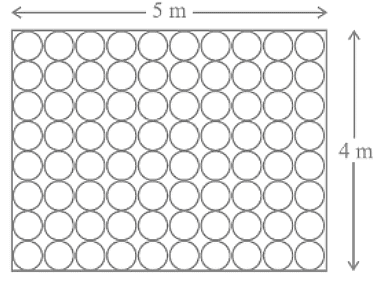
Given, the floor of a room with dimensions 5 m × 4 m is covered with circular tiles of diameters 50 cm.
We have to find the area of the floor that remains uncovered with tiles.
Area of floor of a room = length × breadth
= 5 × 4
= 20 m²
Given, diameter of each circular tile = 50 cm
Number of tiles in each row = 5m/50cm
1 m = 100 cm
= 500/50
= 10
Number of tiles in each column = 4m/50cm
= 400/50
= 8
Total number of tiles in the floor = 10 × 8 = 80
Radius of tiles = 50/2 = 25 cm
r = 25/100
r = 0.25 m
Area of circle = πr²
Area of circular tile = (3.14)(0.25)²
= 0.19625 m²
Area of 80 tiles = 80(area of one tile)
= 80(0.196)
= 15.7 m²
Area of the floor that remains uncovered with the tiles = area of floor - area of 80 tiles
= 20 - 15.7
= 4.3 m²
Therefore, the area of the floor that remains uncovered with the tiles is 4.3 m².
Q.12. All the vertices of a rhombus lie on a circle. Find the area of the rhombus, if area of the circle is 1256 cm2 . (Use π = 3.14)
Given, all the vertices of a rhombus lie on a circle.
Area of the circle = 1256 cm²
We have to find the area of the rhombus.
All the vertices of a rhombus lie on a circle. Find the area of the rhombus, if area of the circle is 1256 cm². (Use π = 3.14)
From the figure,ABCD is a rhombus whose vertices lie on a circle.d₁ and d₂ are the diagonals of the rhombus.
Area of circle = πr²
1256 = 3.14r²
r² = 1256/3.14
r² = 400
r = 20 cm
Therefore, the radius of the circle is 20 cm
Since all the vertices of the rhombus lie on the circle. The diagonal of the rhombus is equal to the diameter of the circle.
Diameter of circle = 2(20) = 40 cm
Area of rhombus = 1/2 × d₁ × d₂
= 1/2 × 40 × 40
= 20 × 40
= 800 cm²
Therefore, the area of rhombus is 800 cm²
Q.13. An archery target has three regions formed by three concentric circles as shown in Fig. 11.19. If the diameters of the concentric circles are in the ratio 1: 2:3, then find the ratio of the areas of three regions.
Given, an archery target has three regions formed by three concentric circles.
The diameters of the concentric circles are in the ratio 1:2:3
We have to find the ratio of the areas of three regions.
The diameter of the first circle = d
Radius = d/2
The diameter of the second circle = 2d
Radius = 2d/2 = d
The diameter of third circle = 3d
Radius = 3d/2
Area of circle = πr²
Area of first circle = π(d/2)²
= πd²/4
Area of second circle = πd²
Area of third circle = π(3d/2)²
= 9πd²/4
Area of the region enclosed between first and second circle = area of second circle - area of first circle
= πd² - πd²/4
= (4πd² - πd²)/4
= 3πd²/4
Area of the region enclosed between second and third circle = area of third circle - area of second circle
= 9πd²/4 - πd²
= (9πd² - 4πd²)/4
= 5πd²/4
Ratio of the areas of three regions = πd²/4 : 3πd²/4 : 5πd²/4
= 1 : 3 : 5
Therefore, the ratio of the areas of three regions is 1:3:5
Q.14. The length of the minute hand of a clock is 5 cm. Find the area swept by the minute hand during the time period 6 : 05 a m and 6 : 40 a m.
Time difference = (6 : 40 am – 6 : 05 am) = 35 min.
Time swept by min hand is 35 min.
Length of min. hand will be radius of circle swept.
∴ r = 5 cm
In 60 minutes time, area swept by min. hand = πr2
In 1 minute time, area swept by min. hand = πr2/60
In 35 minutes time, area swept by min. hand = πr2/60 × 35
∴ Required area swept by min. hand
Hence, the required area swept by him min. hand is
Q.15. Area of a sector of central angle 200° of a circle is 770 cm2. Find the length of the corresponding arc of this sector.
Let the radius of the sector AOBA be r.
Given: Central angle of sector AOBA = θ = 200∘
Area of the sector AOBA = 770 cm2 [Given]
We know that, area of the sector =
∴ Area of the sector, 770 =
⇒ r = 3 × 7
∴ r = 21 cm
So, radius of the sector AOBA = 21 cm.
Now, the length of the corresponding arc of this sector
= Central angle × Radius [∵ θ = l/r]
Hence, the required length of the corresponding arc is
Q.16. The central angles of two sectors of circles of radii 7 cm and 21 cm are respectively 120° and 40°. Find the areas of the two sectors as well as the lengths of the corresponding arcs. What do you observe?
Let the lengths of the corresponding arc be l1 and l2
Given that, radius of sector PO1QP = 7 cm
And radius of sector AO2BA = 21 cm
And central angle of the sector AO2B A = 40∘
∴ Area of the sector with central angle O1and area of the sector with central angle
Now, corresponding arc length of the sector
Now, corresponding arc length of the sector AO2BA
Hence, we observe that arc lengths of two sectors of two different circles may be equal but their area need not be equal.
Q.17. Find the area of the shaded region given in Fig. 11.20.
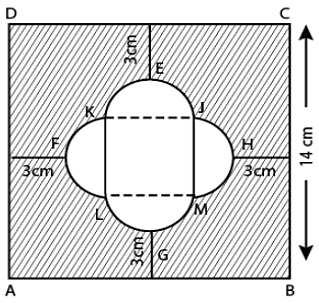
Join JK, KL, LM and MJ
There are four equal semi - circles and LMJK formed a square.
∴ FH = 14 – ( 3 +3 ) = 8cm
So, the side of square should be 4 cm and radius of semi - circle of both ends are 2 cm each.
∴ Area of square JKLM = (4) 2 = 16 cm2
Area of semi - circle HJM = πr2/2
∴ Area of four semi-circle = 4 × 2π cm2 = 8 πcm2
Now, area of square ABCD = (14)2 = 196 cm2
∴ Area of shaded region = Area of square ABCD - [Area of four semi-circle + Area of square JKLM]
= 196 − [8π + 16] = 196 − 16 − 8 π
= (180 − 8 π) cm2
Hence, the required of the shaded region is (180 − 8 π) cm.
Q.18. Find the number of revolutions made by a circular wheel of area 1 .54 m2 in rolling a distance of 176 m.
Given, area of circular wheel = 1.54 m²
Total distance covered by the wheel = 176 m
We have to find the number of revolutions made by a circular wheel.
Area of circle = πr²
1.54 = (22/7)r²
r² = 1.54(7)/22
r² = 0.07(7)
r² = 0.49
Taking square root,
r = 0.7 m
Circumference of the circle = 2πr
Circumference of the wheel = 2(22/7)(0.7)
= 44(0.1)
= 4.4 m
Number of revolutions = total distance / circumference
= 176/4.4
= 40
Therefore, the total number of revolutions made by the wheel is 40.
Q.19. Find the difference of the areas of two segments of a circle formed by a chord of length 5 cm subtending an angle of 90° at the centre.
Chord AB = 5 cm divides the circle in two segments minor segment APB and major segment AQB. We have to find out the difference in area of major and minor segment.
Here, θ = 90°
Area of ΔOAB = 1/2 Base × Altitude = 1/2r × r = 1/2r2Area of minor segment APB
Area of minor segment =
Area of major segment AQB = Area of circle – Area of minor segment
Area of major segment AQB =
Difference between areas of major and minor segment
In right angle ΔOAB , r2 + r2 = AB2
⇒ 2r2 = 52
⇒ r2 =25/2
So, required area =
Q.20. Find the difference of the areas of a sector of angle 120° and its corresponding major sector of a circle of radius 21 cm.
Given, central angle = 120°
Radius of circle = 21 cm
We have to find the difference between the areas of a sector and corresponding major sector of a circle.Find the difference of the areas of a sector of angle 120° and its corresponding major sector of a circle of radius 21 cmConsidering circle with radius 21 cm
Area of circle = πr²
= (22/7)(21)²
= 1386 cm²
Considering sector AOBA
Area of a sector = πr²θ/360°
Area of minor sector AOBA = (22/7)(21)²(120°/360°)
= (22)(3)(21)(1/3)
= (22)21
= 462 cm²
Area of major sector = area of circle - area of minor sector
= 1386 - 462
= 924 cm²
Area of major sector and its corresponding major sector ABOA = area of major sector - area of minor sector
= 924 - 462
= 462 cm²
Therefore, the difference between the areas of a sector and corresponding major sector of a circle is 462 cm²
|
126 videos|457 docs|75 tests
|
FAQs on NCERT Exemplar: Areas Related to Circles - Mathematics (Maths) Class 10
| 1. What is the formula to calculate the area of a circle? |  |
| 2. How can I find the circumference of a circle if I only know the diameter? |  |
| 3. Can you explain what is meant by the term "radius" of a circle? |  |
| 4. Is the value of π always the same? |  |
| 5. How can I calculate the area of a sector of a circle? |  |

|
Explore Courses for Class 10 exam
|

|

 ......[From equation (i)]
......[From equation (i)]








 According to the question,
According to the question,

 From figure, radius of semi circle DFE , r = 6 – 4 = 2 m
From figure, radius of semi circle DFE , r = 6 – 4 = 2 m ∴ Area of shaded region = Area of rectangle ABCD + Area of semi-circle DFE= (32 + 2π)m2
∴ Area of shaded region = Area of rectangle ABCD + Area of semi-circle DFE= (32 + 2π)m2 Here, breadth of the rectangle BC = 12m∴ Breadth of the inner rectangle EFGH = 12 − (4 + 4) = 4cmwhich is equal to the diameter of the semi-circle EJF, d = 4m∴ Radius of semi-circle EJF , r = 2m∴ Length of inner rectangle EFGH = 26 − (5+5) = 16m
Here, breadth of the rectangle BC = 12m∴ Breadth of the inner rectangle EFGH = 12 − (4 + 4) = 4cmwhich is equal to the diameter of the semi-circle EJF, d = 4m∴ Radius of semi-circle EJF , r = 2m∴ Length of inner rectangle EFGH = 26 − (5+5) = 16m = 4πm
= 4πm Radius of each sector(r) = 10/2 = 5 cm
Radius of each sector(r) = 10/2 = 5 cm









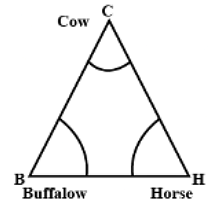

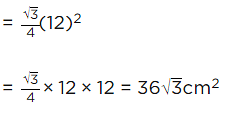
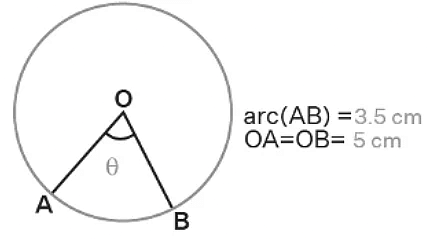 Find the area of the sector of a circle of radius 5 cm, if the corresponding arc length is 3.5 cm Length of the arc = θ/360°(2πr)3.5 = (θ/360°)(2π)(5)3.5 = (θ/360°)(2)(22/7)(5)θ/360° = 3.5(7)/(22)(10)
Find the area of the sector of a circle of radius 5 cm, if the corresponding arc length is 3.5 cm Length of the arc = θ/360°(2πr)3.5 = (θ/360°)(2π)(5)3.5 = (θ/360°)(2)(22/7)(5)θ/360° = 3.5(7)/(22)(10) A, B, C and D are the four circular cardboard pieces of radii 7 cm.On joining the centres, A, B, C and D form a square.
A, B, C and D are the four circular cardboard pieces of radii 7 cm.On joining the centres, A, B, C and D form a square.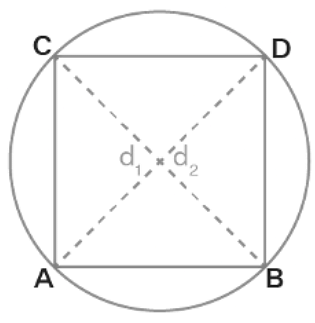 ABCD is a rhombus whose vertices lie on a circle.d₁ and d₂ are the diagonals of the rhombus.
ABCD is a rhombus whose vertices lie on a circle.d₁ and d₂ are the diagonals of the rhombus.

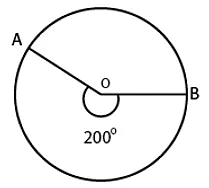 Let the radius of the sector AOBA be r.
Let the radius of the sector AOBA be r.




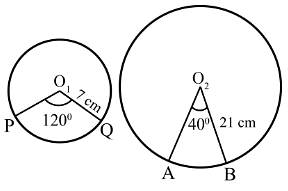

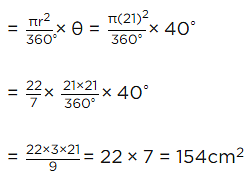

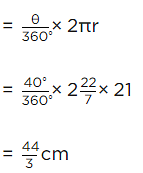

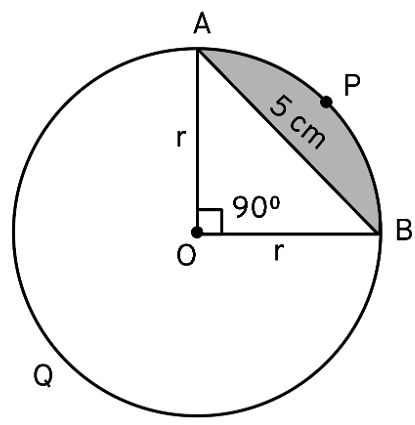 Area of minor segment APB
Area of minor segment APB





 Find the difference of the areas of a sector of angle 120° and its corresponding major sector of a circle of radius 21 cmConsidering circle with radius 21 cm
Find the difference of the areas of a sector of angle 120° and its corresponding major sector of a circle of radius 21 cmConsidering circle with radius 21 cm
















